

Turkey Denim Report – Production, Exports & more: 2000 -2009 - Denim and Jeans. October 5th, 2009 by Sandeep Agarwal | Filed under Denim Reports.
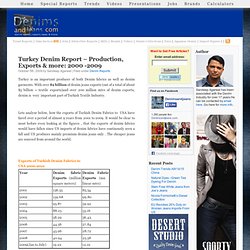
Turkey is an important producer of both Denim fabrics as well as denim garments. With over $2 billion of denim jeans exports (out of a total of about $5 billion + textile exports)and over 200 million mtrs of denim exports, denim is very important part of Turkish Textile Industry. Lets analyze below, how the exports of Turkish Denim Fabrics to USA have fared over a period of almost 9 years from 2001 to 2009. It would be clear to most before even looking at the figures , that the exports of denim fabrics would have fallen since US imports of denim fabrics have continously seen a fall and US produces mainly premium denim jeans only . The cheaper jeans are sourced from around the world.
Turkish Denim Demand - Denim and Jeans. August 21st, 2012 by Sandeep Agarwal | Filed under Denim Reports. Cotton Inc regularly comes out with lifestyle monitor surveys across various countries around the world. In this survey in Turkey(2012) , they come out with interesting facts on denim purchase by Turkish customers. Turkey is already a large denim producing country with both fabric and garment production. Famous denim brands from the country include Mavi, LTB, Cross etc and world famous fabric producing mills like Orta, Isko etc have their base in Turkey. So how does the consumers in Turkey buy denim … Lets have a look at the highlights from the report.
The Global Lifestyle Monitor survey found that Turkish consumers shop more often for clothes than their European counterparts and agree about the value of durable apparel and good prices. 65% of Turkish shoppers say they love or enjoy wearing denim. The Turkish consumers reduced their purchase from unorganized retail – as happens in most economies which are growing fast. Denim, Denmark and Turkish Fast Fashion. Denim, Denmark and Turkish Fast Fashion Sandeep Agarwal has a wonderful website, Denims and Jeans, that keeps tabs on the happenings in the world's denim circles.
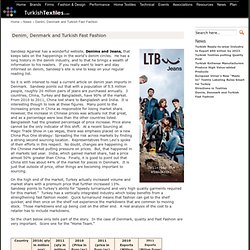
He has a long history in the denim industry, and to that he brings a wealth of information to his readers. If you really want to learn and stay informed on denim, Sandeep's site is one to keep on your regular reading list. So it is with interest to read a current article on denim jean imports in Denmark. Sandeep points out that with a population of 5.5 million people, roughly 20 million pairs of jeans are purchased annually. 3 countries, China, Turkey and Bangladesh, have 90% of the market. On the high end of the market, Turkey actually increased volume and market share with a premium price that further increased 13%.
So the chart below only tells part of the story. TURKISH DENIM FABRIC - Textile, Jeans,Cotton,Yarn. Ethiopia and the IMF. Ethiopia Overview. Economic Overview Ethiopia is the second-most populous country in Sub-Saharan Africa with a population of about 92 million (United Nations, 2012).

One of the world’s oldest civilizations, Ethiopia is also one of the world’s poorest countries. The country’s per capita income of $410 is substantially lower than the regional average (Gross National Income, Atlas Method). The government aspires to reach middle income status over the next decade. The economy has experienced strong and broad based growth over the past decade, averaging 10.6% per year in 2004/05 - 2011/12 compared to the regional average of 4.9%. Economic growth brought with it positive trends in reducing poverty, in both urban and rural areas. Ethiopia has achieved the Millennium Development Goals (MDGs) for child mortality and is on track for achieving them in gender parity in education, HIV/AIDS, and malaria. Ethiopian textile industry final. Spotlight on...Turkey's apparel industry. The traffic in Istanbul is notoriously congested, and the Turkish fashion industry also finds itself approaching an important set of crossroads.
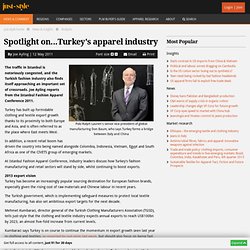
Joe Ayling reports from the Istanbul Fashion Apparel Conference 2011. Turkey has built up formidable clothing and textile export growth thanks to its proximity to both Europe and Asia, and is often referred to as the place where East meets West. In addition, a recent retail boom has driven the country into being named alongside Colombia, Indonesia, Vietnam, Egypt and South Africa as one of the CIVETS group of emerging markets. At Istanbul Fashion Apparel Conference, industry leaders discuss how Turkey's fashion manufacturing and retail sectors will stand by side, whilst continuing to boost exports. 2013 export visionTurkey has become an increasingly popular sourcing destination for European fashion brands, especially given the rising cost of raw materials and Chinese labour in recent years. "I don't quite know what Turkey's niche is," he says.
Wikipédia_Turquie. OCDE - Turquie. Accueil de l'OCDE › Turquie Statistiques Profil statistique de la Turquie Les profils statistiques par pays comprennent un grand choix d’indicateurs sur l’économie, l’éducation, l’énergie, l’environnement, l’aide étrangère, la santé, l’information et la communication, le travail, la migration, la R-D, les échanges et la société.
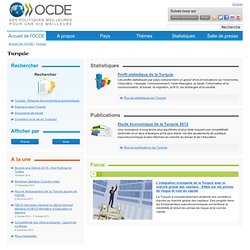
Publications Etude économique de la Turquie 2012 Une croissance à long terme plus équilibrée et plus forte requiert une compétitivité renforcée et un taux d’épargne privé plus élevé, via des ajustements de politique macroéconomique et des réformes du marché du travail et de l’éducation. Focus. OCDE-Turkey-Stats. OCDE-études economiques de la Turquie. Obtenir cette publication | Informations complémentaires Synthèse de l'Étude économique de la Turquie 2012 L’économie turque a connu une reprise vigoureuse après la crise mondiale, mais des déséquilibres macroéconomiques intérieurs et extérieurs sont apparus au cours de ce processus.
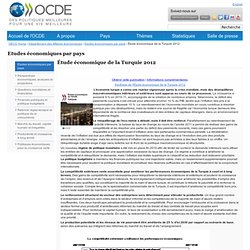
La croissance a avoisiné 9 % en 2010-11, accompagnée de la création de nombreux emplois. ITT_2009. Halit Narin, President of the International Textile Manufacturer?
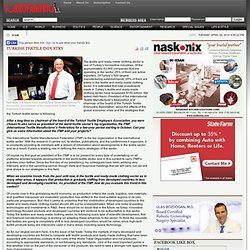
S Association and chairman of the board of the Turkish Textile Employers Association, The textile and ready-made clothing sector is one of Turkey’s locomotive industries. Of the approximately 43,000 companies that are operating in the sector, 25% of them are active exporters. ITT_université technique d'Istanbul. Dr.
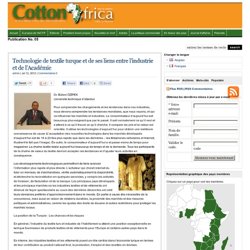
Bülent ÖZİPEK Université technique d’Istanbul Pour comprendre les changements et les tendances dans nos industries, nous devons comprendre les tendances mondiales, que nous voyons, et qui va influencer les marchés et industries. Le consommateur d’aujourd’hui est beaucoup plus exigeant que par le passé. Il sait normalement ce qu’il veut et s’attend à ce qu’il trouve ce qu’il cherche. EU - Conférence Industrie Textile Pays Méditerranée. Des deux côtés de la Méditerranée, des représentants du secteur textile et de l’habillement se sont rencontrés à la mi-mars 2012 à Milan – une des quatre métropoles mondiales de la mode - pour leur réunion annuelle sur l'avenir de leur industrie.
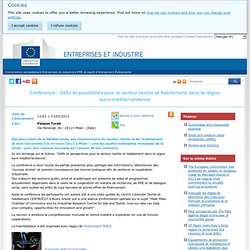
Ils ont échangé sur le thème: "Défis et perspectives pour le secteur textile et habillement dans la région euro méditerranéenne". EU_présentation conférence. Concurrence ITT. Impact Crise sur l'industrie tectile turque (ITT) Le chaos au Moyen-Orient a servi au secteur du textile turc qui avait bien entamé l’année 2011.
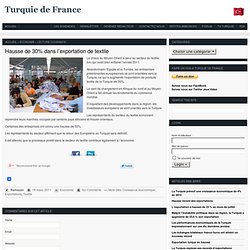
Textile: Pourquoi la Turquie fait peur. Apparel in Turkey. Global insight and local knowledge With 40 years’ experience of developed and emerging markets, Euromonitor International’s research method is built on a unique combination of specialist industry knowledge and in-country research expertise. This approach is what enables us to achieve our goal of building a market consensus view of size, shape and trends across the full distribution universe of each category. We factor in whichever channels are relevant, from large-scale grocery to direct sellers, from discount stores to local mom-and-pop outlets. Industry specialists Each industry we cover is managed by an Industry Manager and team of Industry Analysts who research and report on their specialist categories all year round.
Our collaborative approach to research means that these industry teams are in constant dialogue with industry players and opinion formers. The specialist in-house teams bring together findings from all stages of the annual research process.